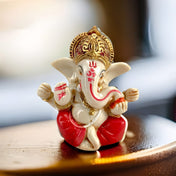Introduction
Goddess Annapurna is highly regarded in Hindu mythology as the goddess of food and nourishment. The Anna purna meaning comes from the Sanskrit words 'anna' (food) and 'purna' (full, complete), representing her role in providing sustenance to all beings.
Nourishment for Body and Soul
In many spiritual traditions, nourishment goes beyond just the physical body. It encompasses the overall well-being of a person, including their mental and spiritual health. Worshiping Goddess Annapurna is believed to bring both material abundance and spiritual fulfillment, creating a balanced life.
Key Aspects Covered
- Mythological Story: The tale of Annapurna Devi highlights her essential role in sustaining the world.
- Symbolism: Understanding the deeper meanings behind her representation of abundance.
- Devotional Practices: Rituals, mantras, and offerings associated with worshiping Annapurna.
- Pilgrimages and Festivals: Personal experiences and significant celebrations honoring her.
- Philanthropic Aspect: How temples dedicated to Annapurna address hunger through charitable activities.
- Contemporary Significance: Revival of interest in her worship among modern-day seekers.
- Practicing Gratitude and Abundance: Drawing on her teachings to enrich daily life.
Discover how embracing these aspects can lead to a more nourished existence for both body and soul.
To complement your devotion to Goddess Annapurna, you may also consider adorning yourself with bohemian silver anklets that symbolize grace and beauty, enhancing your connection with divine energies.
Furthermore, as the auspicious festival of Ugadi approaches, marking the beginning of a new Hindu lunar calendar, it is an ideal time to reflect on the significance of this occasion and celebrate it with much zeal and enthusiasm even if observed thousands of miles away from its origin.
In addition, while worshiping deities like Annapurna, it is customary to offer Indian garlands as a symbol of devotion and adornment. These garlands can be used to decorate photo frames, idols, or even as temple decor.
The Mythical Tale of Annapurna Devi
The legend of Goddess Annapurna holds a special place in Hindu mythology. One popular story narrates how she manifested to teach Lord Shiva the importance of food. When Shiva declared the material world an illusion, including food, Annapurna disappeared, causing widespread famine. Realizing his mistake, Shiva sought her out with a begging bowl. Annapurna then reappeared, filling his bowl with food and restoring nourishment to the world.
Symbolism and Significance
Annapurna's iconography is rich with meaning:
- She is often depicted holding a jewel-studded golden ladle in one hand and a pot overflowing with food in the other, symbolizing her endless bounty.
- Her other two hands typically hold a scripture and a rosary, representing knowledge and devotion respectively.
This imagery reinforces her role not just as a provider of physical sustenance, but also as a source of spiritual and intellectual nourishment.
Role in Sustenance
Annapurna's role extends beyond merely feeding the body; she represents the vital link between physical nourishment and spiritual fulfillment. The belief is that by worshipping Annapurna, devotees can achieve a balance that nurtures both body and soul. Her blessings are sought to ensure that one's home remains a place of abundance and prosperity.
Integrating this understanding into daily practices, such as using an Indian German silver pooja thali set during rituals or adorning spaces with lotus flower cutout decorations, can help create an environment that honors her essence.
The mythological stories and symbolic meanings tied to Goddess Annapurna enrich our appreciation of how ancient traditions weave together the threads of physical sustenance and spiritual growth. Through understanding these tales and symbols, one can better appreciate the holistic approach to nourishment embodied by Annapurna Devi.
Understanding the Symbolism of Annapurna
Goddess Annapurna symbolizes more than just providing food. Her image holding a golden ladle and a pot overflowing with food represents the abundance she gives to her followers.
Representation of Abundance
- Material Wealth: Annapurna is often linked with prosperity and wealth, not only in terms of food but also material possessions. This makes her an important deity for households seeking overall well-being.
- Emotional Fulfillment: The goddess also represents emotional abundance, helping individuals find contentment and joy in their daily lives.
- Spiritual Wealth: Worshiping Annapurna promotes spiritual growth, creating an environment where inner peace and enlightenment can thrive.
Spiritual Nourishment
Practicing devotion to Goddess Annapurna can bring deep spiritual nourishment. Here are some ways:
- Meditative Practices: Followers often use meditative techniques centered around Annapurna to achieve mental clarity and spiritual fulfillment.
- Daily Offerings: Simple actions like offering food or reciting sacred words can establish a direct connection with the divine, enriching one's spiritual journey.
- Community Sharing: Taking part in communal meals or feeding the less fortunate aligns with Annapurna's teachings, reinforcing the belief that sharing sustenance is a spiritual act.
Symbolic Representations
- Golden Ladle and Pot: These objects represent the never-ending provision of nourishment from the goddess, highlighting that true abundance comes from divine blessings.
- Sacred Spaces: Placing an idol or picture of Annapurna in kitchens or dining areas serves as a constant reminder to be grateful for the food we eat.
For those interested in adding symbolic ornaments to their sacred space, consider exploring traditional Indian decor such as small muggu kolam cutout DIY Indian backdrop traditional wall decorations or exquisite and unique handicraft mirrors. These items not only enhance the spiritual atmosphere but also serve as daily reminders of abundance.
The symbolism of Goddess Annapurna goes beyond physical nourishment, offering deep meanings that enrich both the body and soul.
The Devotional Practices: Worship, Mantras, and Offerings
Rituals and Practices in Honoring Goddess Annapurna
Worshiping Goddess Annapurna involves a range of devotional practices designed to invite her blessings into your daily life. These rituals can be simple yet deeply meaningful, creating a spiritual atmosphere that fosters both physical and emotional nourishment.
Guidelines for Placing Her Photo or Idol
One significant practice is the placement of Goddess Annapurna's photo or idol in a sacred space, particularly in kitchens or dining areas. This act transforms the mundane act of cooking and eating into a sacred ritual. By situating her image where food is prepared and consumed, you acknowledge the divine role in sustaining your body and soul.
Daily Offerings: Food, Flowers, and Incense Smoke
Daily offerings form the core of worshiping Goddess Annapurna. These offerings typically include:
- Food: Freshly prepared meals are offered as a sign of gratitude.
- Flowers: Symbolizing purity and devotion.
- Incense Smoke: To purify the environment and create a serene atmosphere.
These offerings serve as tangible expressions of reverence, inviting her blessings into your home.
Powerful Mantras and Hymns
To deepen your connection with Goddess Annapurna, chanting mantras and hymns is essential. Some powerful mantras include:
- Annapurna Stotram: A popular hymn praising the goddess for her abundant blessings.
- Annapurna Ashtakam: This eight-verse chant is known for invoking her grace effectively.
By incorporating these chants into your daily routine, you establish a deeper spiritual bond with the goddess.
For those looking to enhance their devotional setup, consider adding items like crystal diya lamps to your sacred space. These lamps not only add aesthetic value but also symbolize the divine light guiding you towards abundance.
Integrating these practices into your daily life ensures that you remain connected to the divine source of nourishment, both physically and spiritually.
Additionally, you may also consider complementing your devotional practices with traditional accessories like dangle earrings and potli bags. These items not only add cultural significance but also serve as reminders of the devotion and gratitude you hold for Goddess Annapurna.
Experiencing Goddess Annapurna's Grace: Pilgrimages and Festivals
Pilgrimage to Annapurna Temple in Varanasi
Undertaking a pilgrimage to the Annapurna Temple in Varanasi is a profound spiritual journey for many devotees. This temple, situated in the sacred city of Varanasi, holds immense religious significance. Pilgrims often recount their transformative experiences:
- Personal Stories: Many seekers share how the journey to Varanasi and visiting the Annapurna Temple has filled them with a deep sense of peace and gratitude. Standing before the idol of Goddess Annapurna, they feel an overwhelming connection to the divine, sensing her grace and blessings.
- Rituals: The temple rituals include offering rice, grains, and sweets to Annapurna Devi as symbols of gratitude for her nourishment. Devotees also participate in special prayers and chant mantras seeking her blessings.
The Sacred Annapurna Mandir : Kashi Annapurna Temple @ Varanasi
The Annapurna Mandir, also known as the Annapurna Devi Mandir, is a significant pilgrimage site for devotees. The most famous of these is the Kashi Annapurna Temple in Varanasi, considered one of the holiest cities in India.Key features of the Annapurna Mandir include:
- Temple complex: The main shrine is surrounded by smaller temples and sacred spaces.
- Temple premises: The area often includes facilities for pilgrims and spaces for community gatherings.
- Architectural beauty: Many Annapurna temples showcase exquisite craftsmanship, blending various architectural styles.
The Kashi Annapurna Temple, in particular, holds immense spiritual significance. Located near the famous Kashi Vishwanath Temple, it serves as a spiritual base camp for pilgrims visiting Varanasi. The temple was built in the 18th century and continues to be a center of devotion and charity.
Annapurna Jayanti Festival
The Annapurna Jayanti Festival is celebrated with great reverence across India. This festival marks the birthday of Goddess Annapurna and is observed with various rituals and festivities:
- Celebrations: In different parts of the country, devotees organize community feasts where food is distributed freely. Temples are adorned with flowers, lights, and elaborate decorations. Special worship ceremonies are conducted to honor the goddess.
- Spiritual Significance: Celebrating this festival is believed to invoke prosperity and well-being. It serves as a reminder of the importance of food and sustenance, encouraging people to cultivate gratitude for the nourishment they receive.
Exploring these personal journeys and festive celebrations reveals how deeply intertwined Goddess Annapurna's grace is with both everyday life and special spiritual practices. The pilgrimage to Varanasi offers an intimate experience of seeking divine blessings, while celebrating Annapurna Jayanti fosters communal harmony and spiritual growth.
For those interested in similar festivals that celebrate knowledge and wisdom, the Guru Purnima festival provides another perspective on honoring divine figures.
Adding thematic elements like jasmine garlands can enhance your home décor during festive times. Consider using these jasmine garlands for an authentic touch.
If you're looking to celebrate other auspicious occasions, such as weddings, we offer a range of products including a haldi ceremony photo booth party props set which can add fun and vibrancy to your special day.
For more information on related products or decorative ideas that align with these festivities, explore our offerings on LoveNspire.
Goddess Annapurna's Philanthropic Aspect: Feeding the Needy
Temples dedicated to Annapurna are renowned for their free kitchens, which serve meals to both devotees and underprivileged sections of society. These temples with free kitchens stand as a testament to Annapurna's role in addressing hunger and food scarcity issues through their charitable initiatives.
Many of these temples operate on the principle that feeding the hungry is a sacred duty. The Annapurna Temple in Varanasi, for instance, operates a kitchen that provides free meals to thousands daily. This act of generosity is not just about offering sustenance but also about fostering a sense of community and compassion.
Key Aspects of Annapurna's Free Kitchens:
- Inclusivity: Everyone, regardless of caste, creed, or social standing, is welcome.
- Nutritious Meals: Emphasis is placed on providing balanced and wholesome meals.
- Community Service: Volunteers from diverse backgrounds come together to prepare and serve food, embodying the spirit of selfless service.
Temples like these play a crucial role in mitigating hunger and food insecurity. They ensure that no one leaves hungry, reflecting the boundless compassion of Goddess Annapurna. By supporting these initiatives, devotees not only honor her but also contribute to a larger cause.
For those interested in incorporating elements of this tradition into their own homes, items like the Lotus Brass Finish Diya can be used during prayers to invoke blessings. Similarly, using an Annaprasana Backdrop during ceremonies can enhance the spiritual ambiance.
Integrating these practices into daily life fosters a culture of giving and gratitude, aligning perfectly with the teachings of Goddess Annapurna.
Revival and Relevance: Contemporary Significance of Annapurna Worship
An increasing number of modern-day spiritual seekers are rediscovering the importance of Goddess Annapurna. This revival of Annapurna worship reflects a harmonious coexistence with contemporary approaches to food and nourishment.
Renewed Interest Among Spiritual Seekers
Many individuals today are drawn to the holistic benefits that come from worshiping Annapurna. The goddess symbolizes not only physical sustenance but also spiritual fulfillment, aligning seamlessly with a balanced lifestyle.
Integrating Traditional Practices in Modern Living
- Balanced Diets: Adopting rituals associated with Annapurna can promote mindful eating practices.
- Spiritual Nourishment: Incorporating daily offerings and mantras can foster a deeper sense of gratitude and abundance.
Practical Applications
Placing an idol or image of Goddess Annapurna in your dining area can serve as a constant reminder of the importance of nourishment for both body and soul. Daily mantras and offerings enhance this connection, making it more than just a ritual.
To further enhance your devotional practices, you can consider incorporating traditional accessories such as candle holders during prayer times or using a handmade jewelry organizer to keep your spiritual accessories organized.
This renewed interest in Annapurna worship highlights its timeless relevance, blending ancient traditions with modern lifestyles to create a holistic approach to nourishment.
Embracing Abundance and Gratitude in Everyday Life
Goddess Annapurna teaches us the importance of embracing abundance and gratitude for the nourishment we receive, both physically and spiritually. Her teachings inspire a mindset that recognizes the divine blessings in our daily sustenance.
Practical Ways to Incorporate These Values:
- Mindful Eating: Practice gratitude by acknowledging the source of your food. This can be as simple as a silent thank you before meals.
- Daily Affirmations: Begin your day with affirmations that focus on abundance and gratitude. Phrases like "I am grateful for the nourishment I receive" can set a positive tone.
- Generosity: Share your meals with others. This act not only helps those in need but also cultivates a sense of community.
- Simple Rituals: Create small rituals around your meals, such as lighting a candle or setting a beautiful table, to honor the nourishment you receive.
- Reflection: Keep a gratitude journal where you note down things you're thankful for, especially related to food and sustenance.
These practices help integrate the values of abundance and gratitude into your lifestyle, independent of any religious beliefs.
If you're looking to celebrate festivals like Gudi Padwa or Diwali, LoveNspire offers exclusive collections that can add style and significance to your festivities. From Gudi decorations symbolizing victory, prosperity, and happiness in Gudi Padwa celebrations to diya rangoli sets and decor for Diwali, their offerings are designed to make your celebrations unforgettable.
The Divine Alchemy of Nourishing Body and Soul with Goddess Annapurna
Mythological Origins
Goddess Annapurna holds a revered place in Hindu mythology, symbolizing the divine source of nourishment for both the body and soul. The legend narrates how Goddess Parvati incarnated as Annapurna to fill the world with food during a time of scarcity. Her name, derived from the Sanskrit words 'anna' (food) and 'purna' (full or complete), encapsulates her essence as the giver of abundance.
Symbolic Significance
Annapurna's representation transcends beyond mere physical sustenance. She embodies the concept of plentitude and spiritual fulfillment. Worshiping her is believed to bring not only material prosperity but also inner peace and contentment. Her iconography often includes a pot overflowing with food, symbolizing endless bounty and benevolence.
Devotional Practices
Honoring Goddess Annapurna involves various rituals that can be integrated into daily life:
- Placement of Idols: Positioning her idol or image in kitchens or dining areas signifies inviting her blessings into the heart of your home.
- Daily Offerings: Regular offerings of food, flowers, and incense create a spiritual ambiance, invoking her grace.
- Chanting Mantras: Devotees chant powerful hymns to deepen their connection with the goddess.
These practices infuse everyday routines with a sense of sacredness and gratitude.
Real-World Applications
The teachings associated with Goddess Annapurna extend beyond mythological stories. They encourage adopting a holistic approach to nourishment:
- Mindful Eating: By appreciating every meal as a divine gift, you foster mindfulness and gratitude.
- Charity: Inspired by Annapurna's philanthropy, donating food to those in need reinforces the cycle of giving and receiving.
For those seeking to enhance their devotional practices, platforms like LoveNspire offer a range of items such as 2 ct DIY Diwali lantern craft kits for Diwali decoration or wooden laddu gopal sinhasans for pooja mandirs, which can deepen the spiritual ambiance within homes and further enrich the connection with divinity.
Conclusion
Embracing a holistic approach towards nourishment means honoring both your physical needs and spiritual aspirations. Goddess Annapurna teaches us that true abundance encompasses more than just material wealth.
Cultivating gratitude for the abundance in your life is essential. Recognize it as a divine blessing that sustains your journey towards wholeness and fulfillment. By fostering this mindset, you can enrich your daily experiences and deepen your connection to the nourishment you receive.
Key Takeaways:
- Holistic Nourishment: Address both physical and spiritual needs.
- Gratitude: Acknowledge the divine blessings in your life.
- Mindset of Abundance: Embrace a sense of completeness and fulfillment.
Incorporating these values can transform how you perceive everyday nourishment, elevating it to an act of spiritual significance.
For those looking to embrace the essence of Goddess Annapurna in their lives, consider exploring traditional jewelry that honors her here. This collection offers women's South Indian stone adjustable pendant jewelry sets that exude a traditional ethnic oxidized Bollywood look, reflecting the reverence for this deity.
Additionally, for special ceremonies such as weddings or other auspicious occasions, our range of ceremonial garlands here can add a touch of elegance and cultural significance. These garlands include 2 ct artificial pink rose varmalas, perfect for Indian wedding rituals like the milni or varmala exchange between the bride and groom, as well as other cultural celebrations like Muslim Arab or Punjabi Nika events.




















